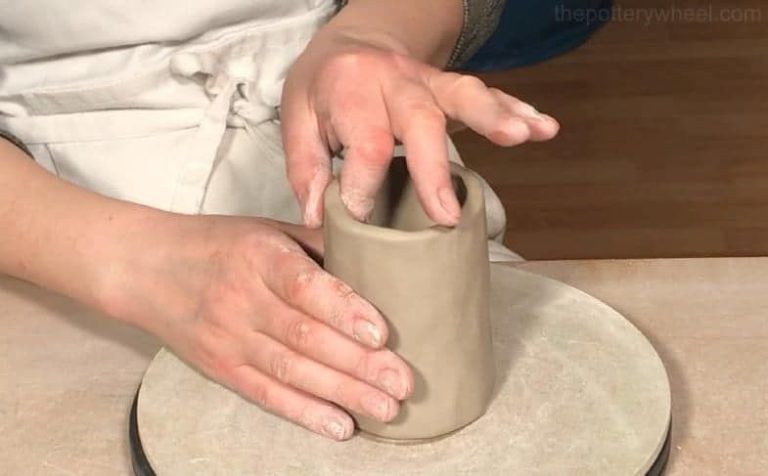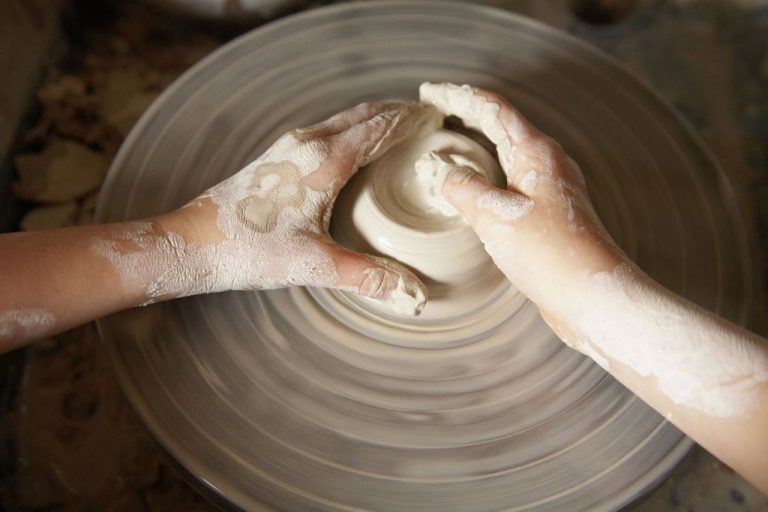What Is Baked Clay Formula?
What is Baked Clay?
Baked clay is clay that has been shaped and then heated to high temperatures in a process called firing. This transforms the clay into a hard, durable material. The firing process changes the physical and chemical properties of the clay through sintering, which fuses particles together, and reactions between clay minerals and fluxes added to the clay body.
Clay is an abundant natural material composed primarily of fine-grained minerals like kaolinite, montmorillonite, and illite. When clay is mixed with water it becomes plastic and can be shaped or molded. Once shaped and dried to remove the moisture, the clay object is fired in a kiln. Firing temperatures typically range from 1,652°F to 2,462°F (900°C to 1,350°C). At these high temperatures, chemical and physical changes occur in the clay that give it its hardness and strength.
The key properties of baked clay are that it is hard, durable, heat resistant, chemical resistant, and can be decorated or glazed. Because of these properties, baked clay is used to make pottery, building materials like bricks and tiles, ceramic cookware and dishware, sculptures, and many other objects.
History of Baked Clay
Baked clay has an ancient history, with the earliest evidence of humans manipulating clay and firing it for use dating back over 30,000 years ago. Baked clay originated as a byproduct of humans constructing fire pits and hearths in the ground, where naturally occurring clay would become fired. Early civilizations like the Jomon in Japan and Native Americans realized they could shape the clay into useful vessels or ceremonial items before intentionally firing it.
The advent of agriculture in the Neolithic Age led to one of the first flourishings of baked clay pottery, with cultures like the Yangshao in China, the Vinča in Eastern Europe, the Halafians in Mesopotamia, and the Norte Chico civilization in South America all producing elegant painted pottery between 5000-3000 BCE. Between 4000-3000 BCE, the invention of the pottery wheel in Mesopotamia allowed for thinner, more uniform ceramic vessels to be produced. This pottery wheel spread across Eurasia and Africa, enabling the mass production of varied baked clay objects.
Over the past 5,000 years, civilizations around the world have continuously improved their techniques for working with clay and innovated new uses for baked clay products, from bricks for architectural construction to porcelain for fine dishware. The composition of clays and glazes has evolved over time and new firing methods using kilns have been developed, allowing for more refined and advanced ceramic ware than in ancient times. Today baked clay remains a ubiquitous and invaluable material worldwide.
Clay Types Used
There are three main types of clay that are commonly used for baking into ceramic ware: earthenware, stoneware, and porcelain.
Earthenware is a basic terra cotta clay that is fired at lower temperatures, typically between 1800°F – 2100°F. It has a coarse, porous body and can be left unglazed. Earthenware clays are very workable and suitable for hand building techniques.
Stoneware clays are fired at higher temperatures between 2200°F – 2400°F. They produce a non-porous, watertight ceramic that can be left unglazed. The higher firing temperature causes the clay particles to fuse, creating a strong final product. Stoneware has good plasticity for throwing on the potter’s wheel.
Porcelain is the most refined clay consisting mainly of kaolin. It fires at very high temperatures over 2300°F. Porcelain has very low porosity and a thin, delicate white body. It requires careful drying and firing methods but produces a smooth, translucent final product that takes glazes nicely. Porcelain is commonly used for tableware, artware, and technical ceramics.
Preparing the Clay
Before clay can be shaped and molded, it must go through a process to prepare it for working with. This preparation stage is crucial for removing air bubbles and inconsistencies in the clay and readying it for further steps.
The primary process used is called wedging. Wedging involves repeatedly cutting the clay into halves or quarters, stacking them on top of each other, then pushing them down and compressing them together. This process evenly distributes moisture, removes air pockets, and aligns the clay particles for proper molding.
Wedging is done on a clean, flat surface like a table or wedging board. Start by cutting a chunk of clay off the main mass and forming it into a ball. Then cut the ball in half and stack one half on top of the other. Apply pressure while pushing the clay away from you, then gather it back up and repeat. Rotate the clay while wedging to distribute the effects evenly.
In addition to wedging, clay can be slammed to release air bubbles. Form the wedged clay into a ball again and throw it forcefully onto the wedging surface. This will help pop any remaining air pockets. Repeat wedging and slamming until the clay is smooth, homogeneous, and ready for molding without cracks or fissures.
The prepared clay should have an even consistency and moisture level, smooth surface, and be free of air pockets. It is now ready for further shaping, molding, and forming the desired baked clay creations.
Shaping and Molding
There are several methods used for shaping and molding baked clay. The most common methods include:
Handbuilding
Handbuilding involves shaping clay by hand without the use of any machinery. Some common handbuilding techniques include pinch pots, coiling, and slab building. With pinch pots, clay is pinched and pulled upwards to form the desired shape. For coiling, ropes or coils of clay are stacked together to build thicker forms. Slab building is done by flattening clay into sheets which can then be cut, shaped, and joined together.
Wheel Throwing
Wheel throwing uses a potter’s wheel to shape clay. The clay is centered on the wheel and then clay is pulled upwards using the momentum of the spinning wheel. Using fingers and tools, the clay can be shaped into symmetrical forms. Wheel throwing allows creating thinner and rounder shapes.
Molding
Molds can be used to form clay into specific shapes. The molds are usually made of plaster or bisque fired clay. Clay is pressed into the mold cavities to take on the exact shape of the mold. Once hardened, the clay is removed from the mold.
Extruding
Clay extruders can be used to push out continuous lengths of shaped clay. Dies determine the exterior shape as the clay is pushed through. Extruding is commonly used to produce smooth, symmetrical, and repeatable forms and shapes.
Drying the Clay
After the clay has been shaped, the next important step is allowing it to dry properly before firing. Drying is a crucial part of the process because any trapped moisture in the clay will turn to steam and potentially crack or warp the piece when fired. There are several methods for drying clay:
Air Drying: The simplest drying method is to allow the clay to sit at room temperature. This allows moisture to slowly evaporate from the clay naturally. Pieces should be placed on dry surfaces, out of direct sunlight and away from drafts which could dry unevenly. Air drying can take several days or weeks depending on the size and thickness of the pieces.
Using Drying Racks: Placing shaped clay on wire drying racks speeds air circulation around all sides of the piece for more effective drying. The elevated racks prevent sitting water under items.
Using a Fan: Directing a gentle fan breeze across the surface of items will accelerate moisture evaporation.
Heating: Placing clay in an oven or kiln on low heat (under 150°F) will gently drive off moisture. Use caution as high temperatures may cause cracking.
No matter the drying method, it’s critical to allow clay to dry thoroughly all the way through before firing. Any remaining moisture will violently turn to steam and potentially crack or destroy pieces. Patience in the drying stage pays off with successful results after firing.
Firing the Clay
The firing process is crucial for hardening and strengthening the clay. Clay that has only been dried but not fired is still porous and fragile. Firing, or baking, the clay at high temperatures transforms the physical properties through a process called sintering.
The most common method for firing clay is kiln firing. Kilns allow reaching the high temperatures needed to vitrify and harden the clay. Electric and gas kilns are commonly used, providing a controlled environment for heating up to over 2000°F (1100°C).
Firing temperatures depend on the type of clay and desired results. Earthenware clays are typically fired from 1800-2100°F (982-1149°C). Stoneware clays require higher temperatures of around 2200-2400°F (1204-1316°C). For porcelain, firing temperatures can go up to 2500°F (1371°C). The clay needs to be heated up gradually to allow gases to escape and prevent cracking and explosions.
Firing schedules vary based on the clay, glaze ingredients, and kiln type. Fast firings heat up and cool down quickly over hours, while slower firings may take days to ramp up and down the temperatures. The clay may go through a single firing, or multiple firings at progressively higher temperatures.
Experienced potters carefully control the kiln temperatures and firing durations to achieve their desired results. The firing process transforms humble lumps of clay into strong, permanent ceramic materials.
Glazing
Glazing is the process of applying a coating to baked clay to create a glass-like surface. The glaze serves both decorative and functional purposes. There are many types of glazes used on baked clay with different characteristics and effects.
The main types of glazes are:
- Glossy glazes – These have a shiny, glass-like finish and are either translucent or opaque.
- Matte glazes – These have a dull, non-reflective surface and can showcase the clay’s natural color.
- Crystalline glazes – These form crystal-like structures and patterns during firing.
- Crackle glazes – These intentionally crack in certain areas during firing for artistic effect.
Glazes are made from various ingredients that melt and fuse to the clay surface during high temperature firing. Common ingredients include silica, clay, feldspar, kaolin, and metal oxides for color. Water is also added to create the right consistency for application.
There are several methods used to apply glazes. These include:
- Dipping – Submerging the clay piece in a vat of liquid glaze.
- Brushing – Using a brush to manually coat the clay.
- Spraying – Spraying the glaze onto the surface using a pressurized sprayer.
- Pouring – Pouring liquid glaze over the surface and allowing it to spread.
Glazes must be fired at high temperatures, usually between 2,100°F to 2,400°F (1,150°C to 1,316°C), to properly melt, fuse, and create the desired effects on the clay surface. The glaze firing schedule must align with the temperature range of the specific glaze type.
Uses of Baked Clay
Baked clay has been used by humans for thousands of years and continues to have a variety of uses today. Some of the most common uses of baked clay include:
Pottery
Clay that has been shaped and fired is used to create pottery including vases, pots, jars, bowls, cups, and various other vessels and containers. Pottery can be functional for storing, cooking, and serving food and beverages. It can also be artistic and decorative.
Bricks
Clay bricks are one of the oldest and most durable building materials. Bricks made of baked clay have been used in construction for millennia across many cultures. Modern clay bricks continue to be a popular siding material and are used in the foundations and walls of homes and buildings.
Tiles
Like bricks, ceramic tiles made of baked clay provide durable and attractive flooring, wall, counter, and roof coverings. Tiles come in a vast range of shapes, colors, sizes, and patterns.
Sculpture
From ancient figurines to modern artworks, baked clay is an important and versatile sculpting medium. The malleability of clay allows artists to shape it into 3D forms which become permanent once fired.
Tableware
Ceramic dishware including plates, bowls, mugs, and more are used for serving food and drink. Clayware provides a smooth, attractive, and sturdy surface for dining.
Notable Examples
Baked clay has been used to create many famous artworks and artifacts throughout history. Some notable examples include:
Terracotta Army
The Terracotta Army is a collection of over 8,000 life-size terra cotta soldier figures that were created in China around 210-209 BCE to guard the tomb of Emperor Qin Shi Huang. This incredible army of detailed clay warriors was only discovered in 1974 near Xi’an, China and has become one of the most famous archaeological finds of the 20th century.
Greek Pottery
Ancient Greek pottery, especially Attic black-figure and red-figure styles from the 6th to 4th centuries BCE, pioneered innovative figurative painting techniques and intricate designs. Many of these Greek vases and containers depicted mythological or everyday scenes and are considered masterworks of antiquity.
Meissen Porcelain
Meissen porcelain, developed at the Meissen factory in Germany in the early 18th century, was the first high quality porcelain to be produced successfully in Europe. Meissen porcelain was highly influential and known for its vivid color palettes and whimsical themes incorporating Asian and European motifs.




